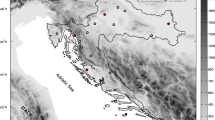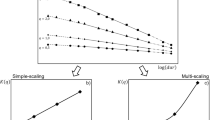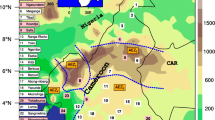Abstract
Statistical modeling of monthly, seasonal, or annual rainfall data is an important research area in meteorology. These models play a crucial role in rainfed agriculture, where a proper assessment of the future availability of rainwater is necessary. The rainfall amount during a rainy month or a whole rainy season can take any positive value and some simple (one or two-parameter) probability models supported over the positive real line that are generally used for rainfall modeling are exponential, gamma, Weibull, lognormal, Pearson Type-V/VI, log-logistic, etc., where the unknown model parameters are routinely estimated using the maximum likelihood estimator (MLE). However, the presence of outliers or extreme observations is a common issue in rainfall data and the MLEs being highly sensitive to them often leads to spurious inference. Here, we discuss a robust parameter estimation approach based on the minimum density power divergence estimator (MDPDE). We fit the above four parametric models to the detrended areally-weighted monthly rainfall data from the 36 meteorological subdivisions of India for the years 1951-2014 and compare the fits based on MLE and the proposed ‘optimum’ MDPDE; the superior performance of MDPDE is showcased for several cases. For all month-subdivision combinations, we discuss the best-fit models and median rainfall amounts.







Similar content being viewed by others
Supplementary information
Codes (written in R) for calculating MDPDEs and their standard errors, optimal tuning parameter selection, and model selection are provided in the Supplementary Material (also available at https://github.com/arnabstatswithR/robustrainfall.git). Tables of the best-fit models and the median rainfall amounts estimated based on the MDPDE from the best-fitted models are also provided.
References
Adham, A., Wesseling, J.G., Riksen, M., Ouessar, M. and Ritsema, C.J. (2016). A water harvesting model for optimizing rainwater harvesting in the wadi Oum Zessar watershed, Tunisia. Agric. Water. Manag. 176, 191–202.
Alam, N., Ranjan, R., Adhikary, P.P., Kumar, A., Mishra, P. and Sharma, N. (2016). Statistical modeling of weekly rainfall data for crop planning in Bundelkhand Region of Central India. Indian J. Soil Conserv. 44, 336–342.
Al-Suhili, R.H. and Khanbilvardi, R. (2014). Frequency analysis of the monthly rainfall data at Sulaimania Region, Iraq. Am. J. Eng. Res. 3, 212–222.
Arjun, K.M. (2013). Indian agriculture-status, importance and role in Indian economy. Int. J. Agric. Food Sci. Tech. 4, 343–346.
Barger, G.L. and Thom, H.C. (1949). Evaluation of drought hazard. Agron. J., 519–526.
Basu, A., Shioya, H. and Park, C. (2019). Statistical Inference: the Minimum Distance Approach. Chapman and Hall/CRC, Boca Raton, USA.
Basu, A. and Lindsay, B.G. (1994). Minimum disparity estimation for continuous models: efficiency, distributions and robustness. Ann. Inst. Stat. Math. 46, 683–705.
Basu, A., Harris, I.R., Hjort, N.L. and Jones, M. (1998). Robust and efficient estimation by minimising a density power divergence. Biometrika 85, 549–559.
Beran, R. (1977). Minimum Hellinger distance estimates for parametric models. Ann. Stat. 5, 445–463.
Burgueño, A., Martinez, M., Lana, X. and Serra, C. (2005). Statistical distributions of the daily rainfall regime in Catalonia (northeastern Spain) for the years 1950–2000. Int. J. Climatol. 25, 1381–1403.
Burgueño, A., Martinez, M.D., Serra, C. and Lana, X. (2010). Statistical distributions of daily rainfall regime in Europe for the period 1951–2000. Theor. Appl. Climatol. 102, 213–226.
Chakraborty, S., Basu A. and Ghosh, A. (2020). Robust clustering with normal mixture models: A pseudo \(\beta \)-likelihood approach. arXiv:2009.04710.
Cox, D.R. and Stuart, A. (1955). Some quick sign tests for trend in location and dispersion. Biometrika, 42, 80–95.
Cressie, N. (1993). Statistics for Spatial Data. John Wiley & Sons, New York, USA.
D’Orazio, M. (2022). univOutl: Detection of Univariate Outliers. R package version 0.4
Duan, J., Sikka, A.K. and Grant, G.E. (1995). A comparison of stochastic models for generating daily precipitation at the HJ Andrews Experimental Forest. Northwestern Science, 69.
Fitzgerald, D. (2005). Analysis of extreme rainfall using the log-logistic distribution. Stoch. Env. Res. Risk. A. 19, 249–257.
Fujisawa, H. and Eguchi, S. (2006). Robust estimation in the normal mixture model. J. Stat. Plan. Inference 136, 3989–4011.
Gajewski, B.J. and Spiegelman, C.H. (2004). Correspondence estimation of the source profiles in receptor modeling. Environmetrics 15, 613–634.
Guhathakurta, P., Koppar, A., Krishan, U. and Menon, P. (2011). New rainfall series for the districts, meteorological sub-divisions and country as whole of India. National Climate Centre Research Report.
Guhathakurta, P. and Rajeevan, M. (2008). Trends in the rainfall pattern over India. Int. J. Climatol. 28, 1453–1469.
Hampel, F.R., Ronchetti, E., Rousseeuw, P.J. and W., S. (1986). Robust Statistics: The Approach Based on Influence Functions. John Wiley & Sons, New York, USA.
Hanson, L.S. and Vogel, R. (2008). The probability distribution of daily rainfall in the United States. In World Environmental and Water Resources Congress 2008: Ahupua’A, pp. 1–10.
Hazra, A. (2022). Minimum density power divergence estimation for the generalized exponential distribution. arXiv:2206.08216.
Hazra, A., Huser, R. and Johannesson, A.V. (2021). Latent Gaussian models for high-dimensional spatial extremes. In Statistical Modeling Using Latent Gaussian Models - With Applications in Geophysics and Environmental Sciences, (B. Hrafnkelsson, ed.).
Hazra, A., Bhattacharya, S. and Banik, P. (2014). Modelling Nakshatra-wise rainfall data of the Eastern Plateau Region of India. Mausam 65, 264–270.
Hazra, A., Bhattacharya S., Banik, P. and Bhattacharya, S. (2017). A note on the misuses of the variance test in meteorological studies. Meteorog. Atmos. Phys. 129, 645–658.
Hazra, A., Bhattacharya, S. and Banik, P. (2018). A Bayesian zero-inflated exponential distribution model for the analysis of weekly rainfall of the Eastern Plateau Region of India. Mausam 69, 19–28.
Hosking, J.R. (1990). L-moments: Analysis and estimation of distributions using linear combinations of order statistics. J. R. Stat. Soc.: Series B (Methodological) 52, 105–124.
Hubert, M. and Vandervieren, E. (2008). An adjusted boxplot for skewed distributions. Comput. Stat. Data Anal. 52, 5186–5201.
Husak, G.J., Michaelsen, J. and Funk, C. (2007). Use of the gamma distribution to represent monthly rainfall in Africa for drought monitoring applications. Int. J. Climatol. A J. R. Meteorol. Soc. 27, 935–944.
Johannesson, Á.V., Siegert, S., Huser, R., Bakka, H. and Hrafnkelsson, B. (2021). Approximate Bayesian inference for analysis of spatio-temporal flood frequency data. Ann. Appl. Stat.
Kaźmierczak, B. and Kotowski, A. (2015). The suitability assessment of a generalized exponential distribution for the description of maximum precipitation amounts. J. Hydrol. 525, 345–351.
Khudri, M.M. and Sadia, F. (2013). Determination of the best fit probability distribution for annual extreme precipitation in Bangladesh. Eur. J. Sci. Res. 103, 391–404.
Krishnamoorthy, K. and León-Novelo, L. (2014). Small sample inference for gamma parameters: one-sample and two-sample problems. Environmetrics 25, 107–126.
Kumar, V., et al. (2017). Statistical distribution of rainfall in Uttarakhand, India. Appl. Water Sci. 7, 4765–4776.
Kwaku, X.S. and Duke, O. (2007). Characterization and frequency analysis of one day annual maximum and two to five consecutive days maximum rainfall of Accra, Ghana. ARPN J. Eng. Appl. Sci. 2, 27–31.
Lana, X., Serra, C., Casas-Castillo, M., Rodríguez-Solà, R., Redaño, A. and Burgueño, A. (2017). Rainfall intensity patterns derived from the urban network of Barcelona (NE Spain). Theor. Appl. Climatol., 1–19.
Madi, M.T. and Raqab, M.Z. (2007). Bayesian prediction of rainfall records using the generalized exponential distribution. Environmetrics 18, 541–549.
Mamoon, A.A. and Rahman, A. (2017). Selection of the best-fit probability distribution in rainfall frequency analysis for Qatar. Nat. Hazards 86, 281–296.
Mandal, S. and Choudhury, B. (2015). Estimation and prediction of maximum daily rainfall at Sagar Island using best fit probability models. Theor. Appl. Climatol. 121, 87–97.
Maposa, D., Cochran, J.J. and Lesaoana, M. (2014). Investigating the goodness-of-fit of ten candidate distributions and estimating high quantiles of extreme floods in the lower Limpopo River basin, Mozambique. J. Stat. Manag. Syst. 17, 265–283.
Martinez-Villalobos, C. and Neelin, J.D. (2019). Why do precipitation intensities tend to follow gamma distributions? J. Atmos. Sci. 76, 3611–3631.
Mattheou, K., Lee, S. and Karagrigoriou, A. (2009). A model selection criterion based on the BHHJ measure of divergence. J. Stat. Plan. Inference 139, 228–235.
Mayooran, T. and Laheetharan, A. (2014). The statistical distribution of annual maximum rainfall in Colombo District. Sri Lankan J. Appl. Stat. 15.
Mooley, D.A. and Crutcher, H.L. (1968). An Application of the Gamma Distribution Function to Indian Rainfall, vol. 5.
Mooley, D.A. (1973). Gamma distribution probability model for Asian summer monsoon monthly rainfall. Mon. Weather Rev. 101, 160–176.
Neykov, N., Filzmoser, P., Dimova, R. and Neytchev, P. (2007). Robust fitting of mixtures using the trimmed likelihood estimator. Comput. Stat. Data Anal. 52, 299–308.
Pohlert, T. (2023). Trend: Non-Parametric Trend Tests and Change-Point Detection. R package version 1.1.6. https://CRAN.R-project.org/package=trend.
Seo, Y., Hwang, J. and Kim, B. (2017). Extreme precipitation frequency analysis using a minimum density power divergence estimator. Water 9, 81.
Sharda, V. and Das, P. (2005). Modelling weekly rainfall data for crop planning in a sub-humid climate of India. Agric. Water Manag. 76, 120–138.
Sharma, M.A. and Singh, J.B. (2010). Use of probability distribution in rainfall analysis. New York Sci. J. 3, 40–49.
Strupczewski, W., Kochanek, K., Weglarczyk, S. and Singh, V. (2005). On robustness of large quantile estimates of log-Gumbel and log-logistic distributions to largest element of the observation series: Monte Carlo results vs. first order approximation. Stoch. Env. Res. Risk. A. 19, 280–291.
Strupczewski, W., Kochanek, K., Weglarczyk, S. and Singh, V. (2007). On robustness of large quantile estimates to largest elements of the observation series. Hydrol. Process. Int. J. 21, 1328–1344.
Todorovic, P. and Woolhiser, D.A. (1975). A stochastic model of \(n\)-day precipitation. J. Appl. Meteorol. 14, 17–24.
Vallender, S. (1974). Calculation of the Wasserstein distance between probability distributions on the line. Theory Probab. Its Appl. 18, 784–786.
Venkateswarlu, B. (2011). Rainfed agriculture in India: issues in technology development and transfer. Model training course on “impact of climate change in rainfed agriculture and adaptation strategies”, 22–29.
Villarini, G. and Serinaldi, F. (2012). Development of statistical models for at-site probabilistic seasonal rainfall forecast. Int. J. Climatol. 32, 2197–2212.
Yuan, Y., Li, C.-T. and Wilson, R. (2008). Partial mixture model for tight clustering of gene expression time-course. BMC Bioinforma. 9, 287.
Acknowledgements
The authors would like to thank an Associate Editor and two anonymous reviewers for their several thoughtful suggestions which improved the flow and the content of the paper substantially. The research of the first author is partially supported by the Indian Institute of Technology Kanpur and Rice University collaborative research grant under Award No. DOIR/2023246.
Author information
Authors and Affiliations
Corresponding author
Ethics declarations
Conflicts of interest
No potential conflict of interest was reported by the authors.
Additional information
Publisher's Note
Springer Nature remains neutral with regard to jurisdictional claims in published maps and institutional affiliations.
Supplementary Information
Below is the link to the electronic supplementary material.
Rights and permissions
Springer Nature or its licensor (e.g. a society or other partner) holds exclusive rights to this article under a publishing agreement with the author(s) or other rightsholder(s); author self-archiving of the accepted manuscript version of this article is solely governed by the terms of such publishing agreement and applicable law.
About this article
Cite this article
Hazra, A., Ghosh, A. Robust Statistical Modeling of Monthly Rainfall: The Minimum Density Power Divergence Approach. Sankhya B 86, 241–279 (2024). https://doi.org/10.1007/s13571-024-00324-0
Received:
Accepted:
Published:
Issue Date:
DOI: https://doi.org/10.1007/s13571-024-00324-0




